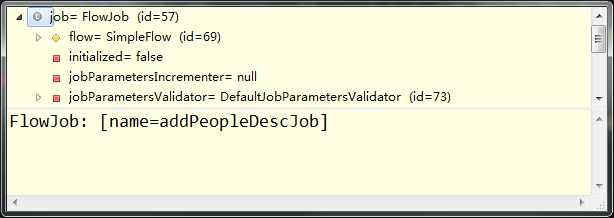Spring Batch_JOB执行流程分析
基于以下job的配置,
<batch:job id="addPeopleDescJob">
<batch:step id="addDescStep" parent="abstractStep">
<batch:tasklet>
<batch:chunk reader="peopleAddDescReader" processor="allowSkipProcessor"
writer="addDescPeopleWriter" commit-interval="2">
</batch:chunk>
</batch:tasklet>
</batch:step>
</batch:job>debug代码
JobExecution result = launcher.run(job,
jobParametersBuilder.toJobParameters());这是启动job的方法,如下是方法的具体实现:
SimpleJobLauncher.java run方法的具体实现(删除了部分代码)
@Override
public JobExecution run(final Job job, final JobParameters jobParameters)
throws JobExecutionAlreadyRunningException, JobRestartException, JobInstanceAlreadyCompleteException,
JobParametersInvalidException {
final JobExecution jobExecution;
jobExecution = jobRepository.createJobExecution(job.getName(), jobParameters);
try {
taskExecutor.execute(new Runnable() {
@Override
public void run() {
try {
job.execute(jobExecution);
}
catch (Throwable t) {
rethrow(t);
}
}
private void rethrow(Throwable t) {
}
});
}
return jobExecution;
}看taskExecutor.execute 方法的主要逻辑,就是把 job execute 封装进一个抽象的任务内,通过taskExecutor 执行 ,taskExecutor 是一个什么类型——org.springframework.core.task.SyncTaskExecutor,一个同步的任务执行类。这样就可以明确的知道每个chunk的处理都是在一个单线程内,循环往复的处理每个commit-interval。
taskExecutor.execute(new Runnable() {
@Override
public void run() {
job.execute(jobExecution);
}
});
继续走代码,那接下来执行的方法是job.execute(jobExecution);那先来看job 是什么类型的对象,

那么就是他了,FlowJob: [name=addPeopleDescJob]。进入job.execute ,
他就直接跳进了 org.springframework.batch.core.job.AbstractJob.execute(JobExecution execution)方法,这是FlowJob的父类,FlowJob 显然没有覆写该方法。
AbstractJob.execute(JobExecution execution)
@Override
public final void execute(JobExecution execution) {
doExecute(execution);
}这是方法的主要执行逻辑,那么这个doExecute方法就是FlowJob实现父类的抽象方法,完成 job的执行的任务。
FlowJob.doExecute()
/**
* @see AbstractJob#doExecute(JobExecution)
*/
@Override
protected void doExecute(final JobExecution execution) throws JobExecutionException {
try {
JobFlowExecutor executor = new JobFlowExecutor(getJobRepository(),
new SimpleStepHandler(getJobRepository()), execution);
executor.updateJobExecutionStatus(flow.start(executor).getStatus());
}
catch (FlowExecutionException e) {
if (e.getCause() instanceof JobExecutionException) {
throw (JobExecutionException) e.getCause();
}
throw new JobExecutionException("Flow execution ended unexpectedly", e);
}
}>>>>>>>>>>>>>>>>>>>>>>>>>>>
继续debug
job是任务的任务的抽象表示,完成的具体任务还要在step中,那么接下来就是step的执行了,step是如何执行的?
我们的代码最终调到这org.springframework.batch.core.step.AbstractStep.execute (StepExecution stepExecution) ,step的抽象类。这个方法的主要逻辑如下:
@Override
public final void execute(StepExecution stepExecution)
throws JobInterruptedException, UnexpectedJobExecutionException {
doExecute(stepExecution);
}这个step又是什么类型的对象——TaskletStep: [name=addDescStep],其父类为AbstractStep。
继续看TaskletStep.doExecute(stepExecution);
@Override
protected void doExecute(StepExecution stepExecution) throws Exception {
stepExecution.getExecutionContext().put(TASKLET_TYPE_KEY, tasklet.getClass().getName());
stepExecution.getExecutionContext().put(STEP_TYPE_KEY, this.getClass().getName());
stream.update(stepExecution.getExecutionContext());
getJobRepository().updateExecutionContext(stepExecution);
// Shared semaphore per step execution, so other step executions can run
// in parallel without needing the lock
final Semaphore semaphore = createSemaphore();
stepOperations.iterate(new StepContextRepeatCallback(stepExecution) {
@Override
public RepeatStatus doInChunkContext(RepeatContext repeatContext, ChunkContext chunkContext)
throws Exception {
StepExecution stepExecution = chunkContext.getStepContext().getStepExecution();
// Before starting a new transaction, check for
// interruption.
interruptionPolicy.checkInterrupted(stepExecution);
RepeatStatus result;
try {
result = new TransactionTemplate(transactionManager, transactionAttribute)
.execute(new ChunkTransactionCallback(chunkContext, semaphore));
}
catch (UncheckedTransactionException e) {
// Allow checked exceptions to be thrown inside callback
throw (Exception) e.getCause();
}
chunkListener.afterChunk(chunkContext);
// Check for interruption after transaction as well, so that
// the interrupted exception is correctly propagated up to
// caller
interruptionPolicy.checkInterrupted(stepExecution);
return result;
}
});
}上面就是TaskletStep.doExecute的完整代码,其中主要的逻辑是:
stepOperations.iterate(new StepContextRepeatCallback(stepExecution) {
@Override
public RepeatStatus doInChunkContext(RepeatContext repeatContext, ChunkContext chunkContext)
throws Exception {
RepeatStatus result;
try {
result = new TransactionTemplate(transactionManager, transactionAttribute)
.execute(new ChunkTransactionCallback(chunkContext, semaphore));
}
return result;
}
});stepOperations.iterate() 方法传入StepContextRepeatCallback的一个匿名对象。
继续debug,转了一圈又回到这个回调方法上StepContextRepeatCallback.doInChunkContext(),
result = new TransactionTemplate(transactionManager, transactionAttribute)
.execute(new ChunkTransactionCallback(chunkContext, semaphore));new TransactionTemplate().execute()方法忽略过去,在这个方法里面最终还要调用ChunkTransactionCallback.doInTransaction() 的回调方法:
@Override
public RepeatStatus doInTransaction(TransactionStatus status) {
RepeatStatus result = RepeatStatus.CONTINUABLE;
result = tasklet.execute(contribution, chunkContext);
return result;
}这个tasklet 的类型是 :org.springframework.batch.core.step.item.ChunkOrientedTasklet ,定义step的执行策略。ChunkOrientedTasklet.execute() 方法:
@Override
public RepeatStatus execute(StepContribution contribution, ChunkContext chunkContext) throws Exception {
@SuppressWarnings("unchecked")
Chunk<I> inputs = (Chunk<I>) chunkContext.getAttribute(INPUTS_KEY);
if (inputs == null) {
inputs = chunkProvider.provide(contribution);
if (buffering) {
chunkContext.setAttribute(INPUTS_KEY, inputs);
}
}
chunkProcessor.process(contribution, inputs);
chunkProvider.postProcess(contribution, inputs);
// Allow a message coming back from the processor to say that we
// are not done yet
if (inputs.isBusy()) {
logger.debug("Inputs still busy");
return RepeatStatus.CONTINUABLE;
}
chunkContext.removeAttribute(INPUTS_KEY);
chunkContext.setComplete();
logger.debug("Inputs not busy, ended: " + inputs.isEnd());
return RepeatStatus.continueIf(!inputs.isEnd());
}Chunk<I> inputs,就是要读入的数据,他是怎么来的 :
inputs = chunkProvider.provide(contribution);chunkProvider 是 org.springframework.batch.core.step.item.SimpleChunkProvider 的类型,provide方法:
@Override
public Chunk<I> provide(final StepContribution contribution) throws Exception {
final Chunk<I> inputs = new Chunk<I>();
repeatOperations.iterate(new RepeatCallback() {
@Override
public RepeatStatus doInIteration(final RepeatContext context) throws Exception {
I item = null;
try {
item = read(contribution, inputs);
}
catch (SkipOverflowException e) {
// read() tells us about an excess of skips by throwing an
// exception
return RepeatStatus.FINISHED;
}
if (item == null) {
inputs.setEnd();
return RepeatStatus.FINISHED;
}
inputs.add(item);
contribution.incrementReadCount();
return RepeatStatus.CONTINUABLE;
}
});
return inputs;
}在 provide 方法内,逐条读取一块数据(通过jdbc游标来读取一条或通过分页来读取多条)item = read(contribution, inputs);然后放入inputs 数据块chunk inputs 。数据读完了(此commit内,根据commit-interval的配置,读取配置的次数或方法返回null表示数据读取完成)接下来就要处理inputs 数据了,到chunkProcessor.process (contribution, inputs) :
@Override
public final void process(StepContribution contribution, Chunk<I> inputs) throws Exception {
// Allow temporary state to be stored in the user data field
initializeUserData(inputs);
// If there is no input we don't have to do anything more
if (isComplete(inputs)) {
return;
}
// Make the transformation, calling remove() on the inputs iterator if
// any items are filtered. Might throw exception and cause rollback.
Chunk<O> outputs = transform(contribution, inputs);
// Adjust the filter count based on available data
contribution.incrementFilterCount(getFilterCount(inputs, outputs));
// Adjust the outputs if necessary for housekeeping purposes, and then
// write them out...
write(contribution, inputs, getAdjustedOutputs(inputs, outputs));
}在chunkProcessor.process 方法内定义了 两个步骤,一个是transform,也就是process读入的数据集合,一个是write。代码跳到transform这:
protected Chunk<O> transform(StepContribution contribution, Chunk<I> inputs) throws Exception {
Chunk<O> outputs = new Chunk<O>();
for (Chunk<I>.ChunkIterator iterator = inputs.iterator(); iterator.hasNext();) {
final I item = iterator.next();
O output;
try {
output = doProcess(item);
}
catch (Exception e) {
/*
* For a simple chunk processor (no fault tolerance) we are done
* here, so prevent any more processing of these inputs.
*/
inputs.clear();
throw e;
}
if (output != null) {
outputs.add(output);
}
else {
iterator.remove();
}
}
return outputs;
}对于 inputs 集合 ,遍历处理后得到 outputs 集合。
output = doProcess(item);上面这行代码就是要调用自定义的process 方法进行处理。然后看write 方法是如何写入数据的,
protected void write(StepContribution contribution, Chunk<I> inputs, Chunk<O> outputs) throws Exception {
try {
doWrite(outputs.getItems());
}
catch (Exception e) {
/*
* For a simple chunk processor (no fault tolerance) we are done
* here, so prevent any more processing of these inputs.
*/
inputs.clear();
throw e;
}
contribution.incrementWriteCount(outputs.size());
}在write 方法内调用了 doWrite() 方法 ,然后调用自定义的 write方法把数据写入。
上面就是 在一次 commit-interval 内的主要过程和主要的逻辑代码。那么 spring batch 是如何重复commit-interval 的呢 (通过RepeatTemplate)?以后再详细说来。
总结:reader,processor和writer过程中数据的处理逻辑
在course reader中,通过游标逐条的读取数据,形成一个inputs chunk,相当于一个集合,然后逐条的处理inputs chunk,进行item process,形成一个outpus chunk,由outputs chunk得到一个集合outputs.getItems(),直接处理这个集合,也就是write方法的参数是一个集合类型。
================END================






















 1133
1133











 被折叠的 条评论
为什么被折叠?
被折叠的 条评论
为什么被折叠?








